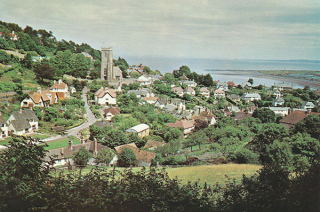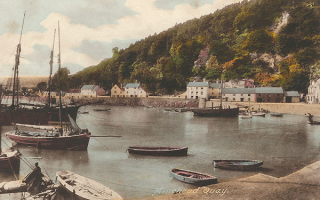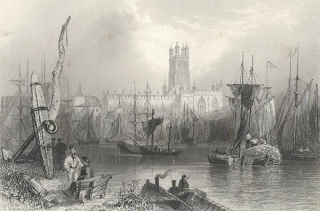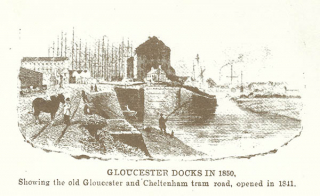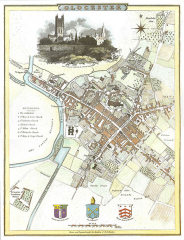The town of Minehead in north Somerset, lies at a point where upland Exmoor meets the lowland and the coast of the Bristol Channel. The North Hill has long provided shelter from the elements to shipping in the bay. St Michael’s church was built on the side of the hill and a beacon was often lit at the top of the tower to guide the ships into harbour.
The first mention of Minehead as a port was in 1380. With the building of jetties in the 15th century, enabling it to provide deeper water for larger vessels, the port grew to not only a successful fishing port but an international trading port, trading not only with Wales (across the Bristol Channel) and with Ireland but also with the European continent as well. However, its fortunes were to fluctuate several times.
In Henry VIII’s time, Minehead possessed more ships suitable for naval use than any other Bristol Channel port. And at the accession of Elizabeth I, Minehead was one of only two Somerset ports with port and customs officials.
But the tides caused a shingle bank to form, impeding access to the quays. Radical measures were needed but the finances were not available and so, without major repairs for most of the Queen’s reign, the harbour’s condition gradually worsened and the town’s population declined.
New quays were built in 1616, which form the basis of the present harbour. The town, on the side of the Parliamentarians, saw action in the Civil War in 1642 and 1643. In the years after the war, the town was extremely busy, both with despatching troops to Ireland and with trade, both legal and non legal as, along with the important merchant families which established themselves in the town came the smugglers too.
However, by the late 17th century, the harbour was silting up again and more work was undertaken in 1682 to enable the harbour to take larger vessels once more.
And so, in the early 18th century, at the time when Thomas and Joan were setting up home, trade was booming and the harbour was described as the safest on the south side of the Bristol Channel and a fine port.
As the costs of maintaining the harbour soared and were passed on to the merchants, they looked for cheaper harbours elsewhere. The local woollen industry, on which much of Minehead’s trade depended, failed. And by the late 18th century trade and the fisheries had declined dramatically.
At the beginning of the 1700s, upwards of forty vessels regularly sailed to Ireland with many others to the West Indies, Virginia and beyond but by 1791 there were only five or six vessels belonging to the port.
The population declined and there were two serious fires, the first being in 1791. Minehead hit rock bottom and those who had no work moved away. There were 2,000 people in 1790 but only 1,480 in 1830. By then the town had begun to develop as a bathing place, a resort, as it is today, but that was of no use to those who were mariners or involved with the trading ships.
This was the situation in which Peter Martin junior, a mariner and customs officer found himself. By 1822 he and his wife Ann had had thirteen children but the trade on which he relied for his work and income was drying up. We can imagine that Peter and Ann had many anxious conversations about the future.
Further inland, on the River Severn, the city of Gloucester had formally become a port in 1580. It had its own custom house although few foreign-going vessels reached the port because of difficulties in navigating the shallow tidal stretch of the River Severn as it approached the city.
It was decided to build a canal between Gloucester and Sharpness (further down river on the Severn) thus allowing ships to bypass the difficult stretch of water, to reach the city and for trade to be developed.
More docks were built and the canal was opened in 1827. With their sails furled, ships were towed the sixteen miles from Sharpness to the Gloucester docks basin, initially by horses and later by tugs. Gloucester was linked to the Midlands by the River Severn and a network of canals, along which goods were transported by barges and later by the railway. Trade was growing and so was the Customs House. Not only was a new and bigger building needed, additional officers were required.
And so Peter and Ann and those of their children still at home, moved to Gloucester, where he was a custom house officer at Gloucester Docks.
Daughter Mary, baptised in 1816, had married Nathaniel Dean, a widower, in 1835, in Leckhampton (which is about two miles from Cheltenham and ten miles from Gloucester). As Mary’s sister Charlotte had been buried in Minehead in 1826, it is probably safe to assume that the family had moved to Gloucester between 1826 and 1835.
In 1841, living with Peter and Ann on Quay Street were their children: Catherine, baptised in 1815, a milliner, George, baptised in 1820, a plumber and Henry, baptised in 1822, who was still at school.
Less than half a mile away, living at St Mary de Lode, were their son Whitfield, a baker, and his wife Mary. Whitfield and Mary had married in Minefield in 1840 but perhaps they decided to join the Martin family in Gloucester (before moving to Chepstow and then back to the Somerset coast at Watchet).
Just twenty days after the 1841 census, George married Mary Cowley. He gave his father’s occupation as ‘locker’. This meant that Peter was employed in the bonded warehouses in Gloucester. Unlike the merchant company warehouses, bonded warehouese were operated by the Customs Service. Security was high; the warehouses were in the charge of Custom’s Officers and were said to be under the King or Queen’s locks.
By 1851, Peter had retired and he and Ann had moved to Cardiff House, Norwood Terrace, Leckhampton. They died in Leckhampton, Peter in 1853 and Ann in 1857.
With Peter and Ann in 1851 were their granddaughters, Ellen and Rosa Beard, aged 11 and 10. According to the 1851 census, Ellen was born in Wolverhampton, Staffordshire and Rosa in Gloucester.
The census was taken on 30 March, which means that Ellen would have been born in 1839/40 and Rosa in 1840/41. Unfortunately, I can find no trace of their births in the civil registration index or the parish registers nor can I find them in the 1841 census.
Catherine Martin
However, Ellen and Rosa would appear to be the daughters of Catherine Martin and William Beard as, by 1851, Catherine had become Catherine Beard and Rosa gave her father’s name as William Beard when she got married. Unfortunately, I can find no trace of a marriage between Catherine and William.
In 1841 Catherine Martin was staying with her parents in Quay Street, Gloucester and William (Wm) Beard was living on his own, in Bear Land, which is the continuation of Quay Street.
William was aged 30 (which, on the 1841 census, means he was aged anything from 30-34, born between 1807 and 1811). He was living on his own, was born out of Gloucestershire and he was a customs officer, presumably a work colleague of Catherine’s father. Unfortunately, the 1841 census didn’t give people’s marital status.
It is possible that William and Catherine were married by then, that Catherine was pregnant with Rosa and so was staying with her mother. And that a simple mistake was made, referring to Catherine as Catherine Martin, not Catherine Beard.
But if so, where were they married and, at the time of the census, in June 1841, where was their daughter Ellen who, according to the 1851 census, was born in 1839 or 1840?
I can find no trace of William Beard, a customs officer, in the 1851 or 1861 censuses. However, there were at least three deaths of a William Beard in Gloucester between 1841 and 1851 and, in 1851 Catherine was a widow, a live-in servant in a school in Cheltenham and ten years later she was a live-in housemaid at the General Hospital in Cheltenham.
In 1861 Rosina Beard was 20, a nurse in a household in Cheltenham, born in Gloucester City.
Rosa married Frederick Foote in 1865, in Leckhampton, giving her father’s name as William Beard. Both he and Frederick’s father were Custom House Officers. Her uncle Henry Martin and sister Ellen Beard were witnesses.
By 1869 the couple had moved to Margate, in Thanet, Kent where their son was born. It seems that Catherine moved with her daughter and son in-law to Kent, as she died in Thanet in 1870. She was aged 55 (born c1815).
Apart from witnessing her sister’s wedding in 1865, there is no easily identifiable sign of Ellen Beard after 1851.
Henry Martin
Henry and his wife Jane also lived at Cardiff House, Norwood Terrace, Leckhampton, in 1851. They were both teachers. Jane was from Watchet, Somerset, where they had married in 1842 and where their children Cleora, Walter and Anthony were born.
Sadly, Jane died in 1852, possibly from childbirth complications as that was the year their daughter Jane Louisa was born.
In 1853 Henry married Olivia Lucy Jones, a school mistress born in London. They had four children: George, Alice Mary, Anne and Kate. He was a school master in Leckhampton from at least 1851 to 1881 and he died in 1884.
Mary Martin
Also living with Henry and Jane in 1851 were the sons and daughters of Henry’s sister, Mary: Henry, Mary Ann, Charles and Eliza Edwards. Eliza, aged 12, was still with her uncle and his family in 1861.
Mary’s husband, Nathaniel Dean, had died in 1837 after just two years marriage in which there were no children. She married Job Edwards in 1839 in Cheltenham but sadly he had died in 1848. And so, by 1851 she was a widow, a live-in nurse in a household in Cheltenham whilst her children were living with her brother Henry and his wife Jane. She was with the same household in 1861.
By 1881 Mary was a retired nurse, boarding with her daughter Eliza Edwards, who was a lodging house keeper in Cheltenham. Ten years later Mary was a boarder with a family in Cheltenham. She died in 1897 aged 81 and was buried in Leckhampton.
By 1891 Eliza had become an innkeeper in the parish of Hanley Castle, Upton on Severn, Worcestershire. Her mother’s sister Betsey (Elizabeth) was then assisting her.
And so we come to George Martin, baptised in 1820.
Next: The Two Georges
Sources:
Old occupation names: tide waiter: http://rmhh.co.uk/occup/t.html
Old occupation names: locker: http://rmhh.co.uk/occup/l.html
English Heritage Extensive Urban Survey: An archaelogical assessment of Minehead, by Clare Gathercole
Port of Gloucester: http://www.gloucesterdocks.me.uk/studies/port.htm
Brief History of the Sharpness Canal: http://www.gloucesterdocks.me.uk/studies/history.htm
